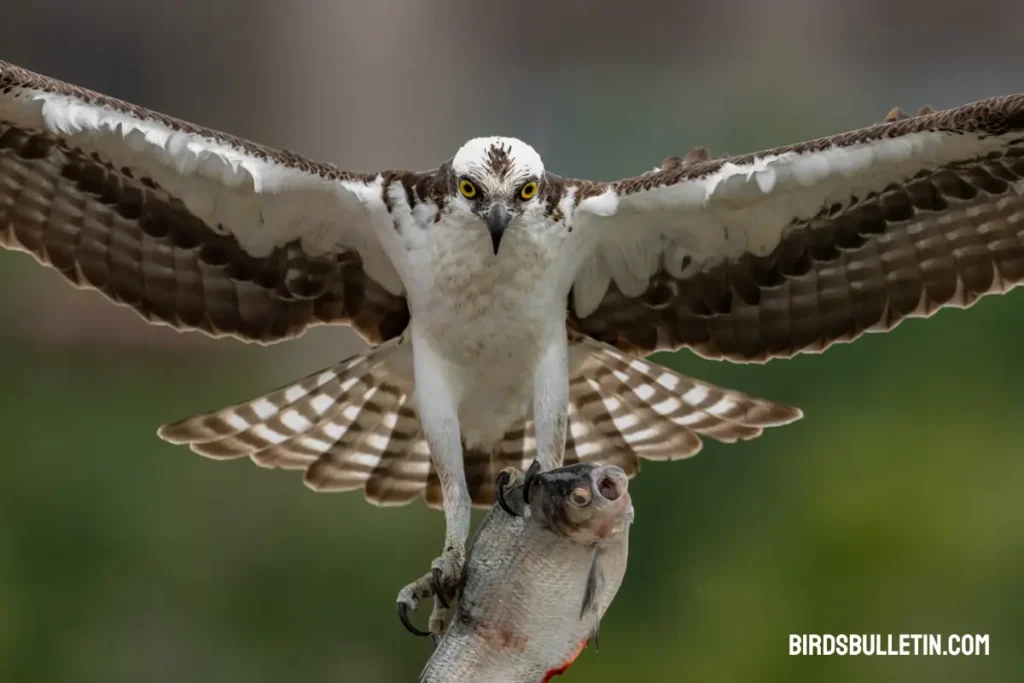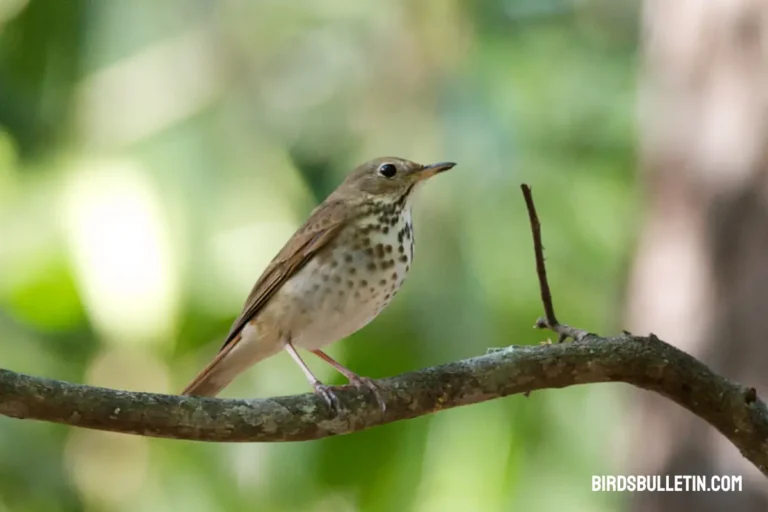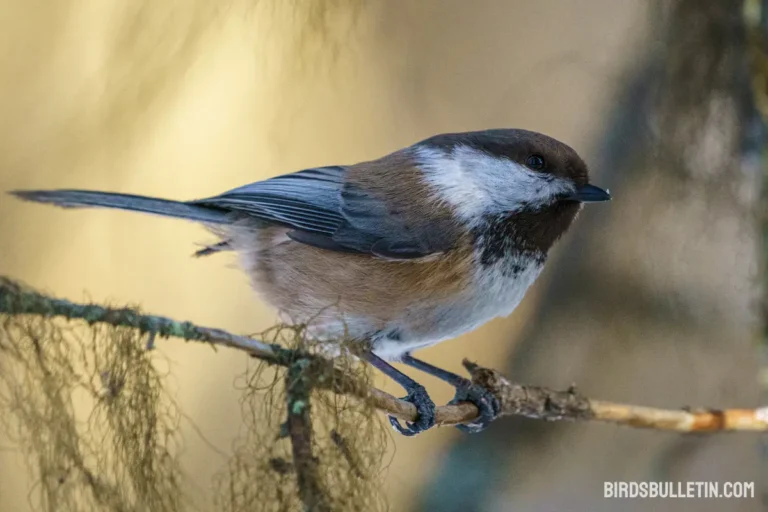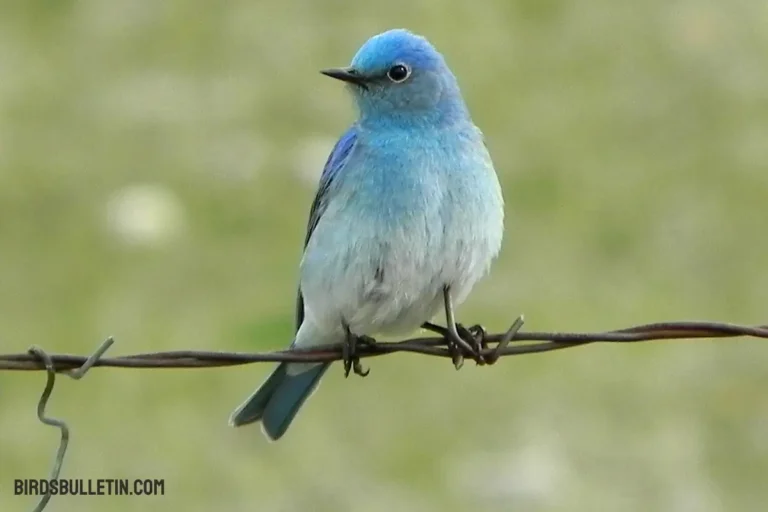The Osprey Bird: Consummate Fish Hawks
The osprey exhibits a distinctive silhouette in flight with dark upper body feathers contrasting white underparts and long, angled wings adept at maneuvering skillfully over lakes and rivers while hunting.
Often called fish hawks or sea hawks for expertise snatching aquatic prey in dagger-like talons, ospreys thrive along coastlines, lakes, and rivers continent-wide thanks to specialized adaptations for piscivorous diets.
Want to learn more about Birds Overview
Identification Step-by-Step
Identifying an osprey involves observing various physical characteristics and behaviors. Here’s a step-by-step guide to help you identify an osprey:

Size and Shape:
- Ospreys are medium to large birds of prey.
- They have a wingspan of about 4.5 to 6 feet.
- Ospreys have long, narrow wings with a distinct bend at the wrist when flying.
Coloration: Adult ospreys have a distinctive appearance. They are mostly white on the head and underparts. The upperparts are dark brown, and they have a distinctive dark eye stripe that extends down the side of their face.
Head and Facial Features: Ospreys have a white crown on their head, and their eyes are yellow. They have a dark line through the eyes that resembles a mask, extending to the back of the head.
Belly and Chest Markings: The chest and belly of an osprey are mostly white, sometimes with faint streaks or spots.
Feet and Talons: Ospreys have reversible outer toes and spiny soles on their feet to help them grasp slippery fish. Their talons are sharp and adapted for catching and holding onto fish.
Flight Pattern: Watch the flight pattern. Ospreys often hover in the air before making a dive to catch fish. They fly with a characteristic kink in their wings, making an “M” shape, especially when gliding.
Juvenile Ospreys: Juvenile Ospreys may have more mottled or streaked plumage, and their eyes may be orange rather than yellow.
Call: Listen for their call, which is a series of sharp whistles or chirps.
Osprey Profile
| Characteristic | Information |
|---|---|
| Scientific Name | Pandion haliaetus |
| Alternative Name | Fish Hawk, Sea Hawk, River Hawk |
| Color | Predominantly brown on the upperparts, white on the head and underparts |
| Size | Approximately 20–28 inches (50–66 cm) in length |
| Wingspan | Around 50-71 (127–180 cm) |
| Weight | 2.0–4.6 lb. (0.9–2.1 kilograms) |
| Lifespan | On average 7-10 years, recorded 20-25 years |
| Breeding Season | From January to May |
| Lay Eggs | Clutch size ranges from 1 to 4 eggs |
| Diet and Prey | Primarily fish; adept at catching and consuming a variety of fish species |
| Threats and Predators | Human activities (habitat destruction, pollution), natural predators (eagles, owls), and environmental changes |
| Locations | Found globally, spanning regions such as North and South America, Europe, Asia, Africa, Australia, and more; often near bodies of water |
State Bird And Symbol
The Osprey represents a conservation success story and is the state bird of numerous states across the U.S. as a proud symbol of environmental revival, including Rhode Island, Montana, and Nebraska. It is also the provincial bird of Nova Scotia, Canada.
Subspecies
The osprey is the only bird of prey with a global distribution across all continents. Four subspecies are generally recognized, though sources differ on which subspecies are officially accepted.
1. Pandion haliaetus, the nominate subspecies found in the Palearctic realm, was originally described by Linnaeus in 1758.
2. Pandion haliaetus carolinensis, described by Gmelin in 1788, inhabits mainland North and South America. It is larger than haliaetus, with a darker body and lighter breasts.
3. Pandion haliaetus ridgwayi, named by Maynard in 1887, is found in the Caribbean islands. It displays a noticeably pale head and breast, with a faint eye mask, and does not migrate.
4. Pandion haliaetus cristatus, described by Vieillot in 1816, is the smallest subspecies, living along the coasts of Australia and Tasmania. Like Ridgway, this variant does not migrate.
Nesting And Habits
Here are some key aspects of their nesting and habits:
Nesting Sites:
- Ospreys are renowned for their impressive nests, often built on elevated structures like tall trees, cliffs, or artificial platforms such as utility poles and channel markers.
- They show a strong preference for locations near water bodies like rivers, lakes, or coastal areas, as their primary diet consists of fish.
Nest Construction:
- Ospreys are skilled builders, and their nests are large and bulky structures made primarily of sticks and branches. They may also incorporate softer materials like moss, seaweed, or grass to line the nest.
- The male is typically responsible for collecting and providing materials, while the female takes the lead in arranging and building the nest.
Breeding Behavior:
- Ospreys are monogamous birds, forming long-term pair bonds. Mating pairs often return to the same nesting site year after year.
- Breeding season varies geographically but generally occurs in the spring or early summer.
Egg-laying and Incubation:
- The female osprey typically lays two to four eggs, and both parents take turns incubating the eggs.
- The incubation period lasts around 35 to 42 days, during which the parents diligently guard and care for the eggs.
Parental Care:
- Once the eggs hatch, both parents are actively involved in feeding and protecting the chicks.
- Osprey chicks grow rapidly, and the parents provide them with a diet consisting mainly of fish, which they catch by diving into the water with their talons.
Fledging:
- Young ospreys, known as fledglings, begin to fledge around 7 to 10 weeks after hatching. During this time, they practice flying and hunting skills under the watchful eyes of their parents.
- The fledglings may continue to receive parental care for several weeks as they hone their abilities.
Population
The global population currently stands at around 460,000 adults worldwide. Though still recovering in some regions, most osprey numbers increased over the past century thanks to reduced pesticide use and nesting protections.
Migration
Northern ospreys undertake long annual migrations up to 5000 km between North American breeding grounds and South American wintering areas. Southern populations reside more permanently in home ranges while some Australian ospreys migrate through Asia.
Behavior
Renowned Fishers: Ospreys are celebrated for their fishing prowess, plunging talon-first to snag slippery prey. Their reversible outer toes and sharp claws facilitate a secure grip, making them consummate hunters of fish.
Seasonal Nesters: Mating pairs construct expansive nests atop dead trees, utility poles, or conservationist platforms. Comprised of sticks and driftwood, these nests are continually maintained across breeding seasons.
Devoted Partners: Ospreys form lasting bonds, cooperating in nesting duties and offspring care. Mates collaborate when incubating eggs and demonstrate intense loyalty across the years.
Intrepid Migrants: Guided by prey and fair winds, Ospreys undertake vast migrations between far-flung seasonal homes. Though journeying thousands of miles along favored routes, they faithfully return to lifelong partners and territories.
Adaptable Defenders: Displaying great adaptability, ospreys thrive across diverse aquatic habitats. They fiercely defend nesting sites, confronting intruders with intense aerial displays.
Interhuman Connection
Like ospreys, we too seek loyalty in partnership, building trust through seasons of thick and thin. In isolation, we may drift, yet some inner compass calls us to mesh sticks and souls alike in shared purpose under open skies.
For within even one outstretched hand may await the embrace of true kindred, and in two wings uplifted as one, the soaring heights love alone makes possible.
Conservation Status
After severe 20th-century declines from DDT pesticides thinned eggshells, osprey protections allowed populations to rebound well across North America and Eurasia. Their adaptability earns ospreys reasonably secure global status.
Legal Protections
In the U.S., the Migratory Bird Treaty Act prevents direct nest destruction while several states enacted additional safeguards regarding habitat buffers and living with nesting ospreys that now often occupy cell towers and utility poles creating occasional conflicts.
Frequently Asked Questions
01. How do ospreys catch fish so effectively?
Sharp reversible outer talons, dive speed momentum, and precision target tracking allow them to plunge feet-first to snatch near-surface fish successfully in about 1 in 4 tries – the highest success rates among hunting raptors.
02. Why do ospreys make such large nests?
Ospreys build some of the largest nests in the raptor world, up to 6 feet wide and 3 feet tall! Their bulky nests provide a sturdy platform for mating, raising young, and sheltering from weather.
03. How far do ospreys migrate?
Some ospreys undertake astonishingly long migrations of up to 3,700 miles between their breeding and wintering habitats. They tend to return to the same sites and even the same nests year after year.
Final Word
The osprey’s magnificent adaptation to careers catching fish positions them as consummate aquatic hunters worldwide. By protecting the waterways, they monitor as sentinels of sustainability for interconnected wildlife and fisheries, ospreys continue thriving as icons of healthy coasts, rivers, and wetlands for eons to come.
References
- Cornell Lab of Ornithology. Osprey Life History. https://www.allaboutbirds.org/guide/osprey
- Kauffman, Kenn. (1996) Lives of North American Birds. Houghton Mifflin Field Guides. Boston, MA.
- Poole, A.F., Bierregaard, R.O. and Martell, M.S. (2002). Osprey (Pandion haliaetus). In The Birds of North America (P. G. Rodewald, editor). Cornell Lab of Ornithology, Ithaca, New York, USA. https://doi.org/10.2173/bna.683







